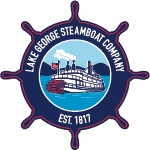About Us
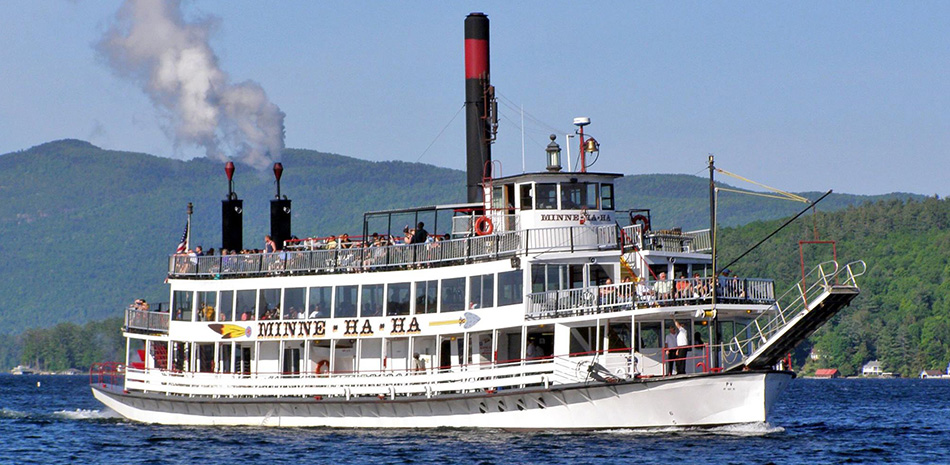
The Minne-Ha-Ha is one of the last steam paddle wheel ships in America. She is perfect for kids and families with tight schedules. She takes an hour-long cruise, 6 times a day along with a Friday night Pirate Adventure Cruise. Guests will be delighted with the Minne’s authentic steam calliope concert in between each cruise. The Minne also has a new event called “Rock the Dock” with live entertainment. It doesn’t get much better than sailing along, listening to good music in the soft summer evening air!
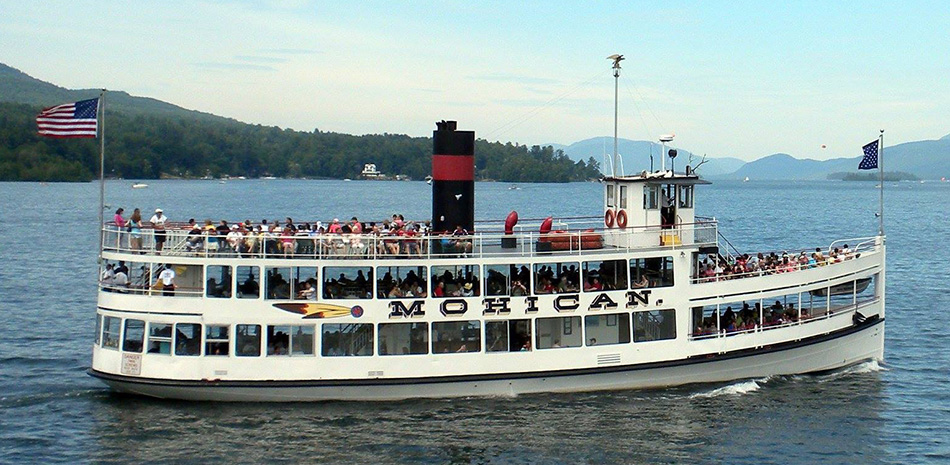
The Mohican, the oldest continuously operated tour boat in America, was launched in 1908. The Mohican offers a variety of cruises. Tour 28 of the 32-mile long Lake George or cruise into Paradise Bay and the Islands of the Narrows. Weeknight evenings, bring your appetites and join us for fun, family oriented dinner cruises (Taco Tuesday, Mac ‘n Cheese Wednesday, Pizza Thursday, and Fiesta (Taco) Friday).
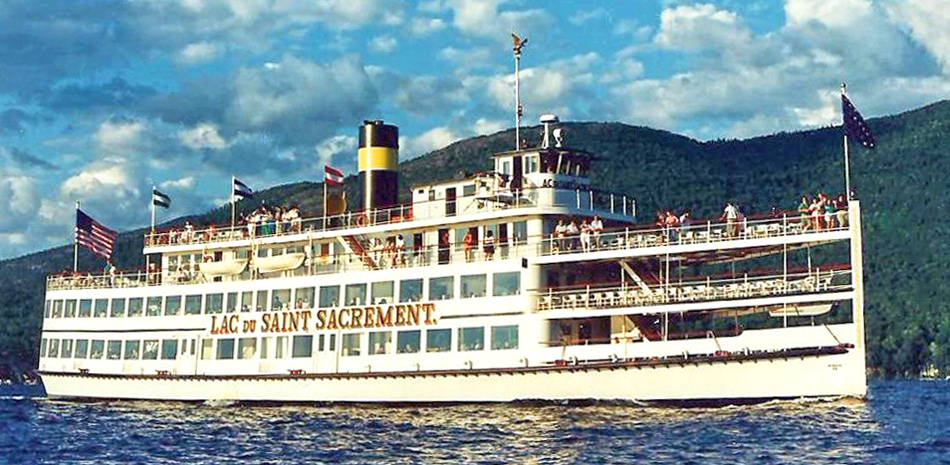
The 190 foot long Lac du Saint Sacrement is the largest cruise ship on the inland waters of New York State. She offers two-hour sightseeing, luncheon and dinner cruises. On Sundays, a Champagne Brunch cruise is also offered and is a real favorite! Entertainment and narration are both included aboard our Saint Sacrement meal cruises.
Our popular Fireworks Cruise launches every Thursday night throughout the summer – weather permitting.
All of our ships are available for group tours, charters, private parties, and weddings of any size!
Group Rates are available; please contact us at 518-668-5777, ext. 205 or info@lakegeorgesteamboat.com.
Want to stay up to date with us while on the road? Click Here, to visit us on Facebook!
PLEASE NOTE: No coolers or outside food/drink allowed on board. Large carry-ons/purses/strollers may be checked by the ship’s officer prior to boarding.
BRIEF COMPANY HISTORY
The first commercially successful steamboat service in America was inaugurated by Robert Fulton. His steam-powered paddle boat, the Clermont, sailed up the Hudson River from New York City to Albany, arriving at the state capitol on August 19, 1807 after 32 hours running time.
Steamboats did not arrive on Lake George until 1817. The settlements along the shores of the lake were small, local business was slight and there was a general antipathy towards steamboats as being somehow connected with the Devil. But the success of steam on nearby Lake Champlain was undeniable and probably contagious.
On April 15, 1817 a company was incorporated by the New York State Legislature to operate commercial shipping on Lake George. The title given this company was the Lake George Steamboat Company.
The first steamship, the James Caldwell, started plying the waters under our banner in 1817. She had a wooden hull, primitive steam engines and was able to steam to the other end of the lake in about 8 hours (the present day Mohican can make it in just under 3 hours). As time rolled on, steam technology and ship building practices allowed for the building of larger and faster wooden hulled ships.
Following the Civil War, through a series of transportation consolidations, the Steamboat Company became part of the Delaware and Hudson Railroad System, serving as a link in that company’s New York City to Canada operations. In 1882 a railroad branch was built between Glens Falls and Lake George. Passengers would step off the train at the still-existing railroad station (across the street from the Steel Pier and built in 1911) and onto the steamers for the trip up the lake to Ticonderoga. They could then board a train that would take them to Canada.
The D&H railroad owned and operated the Lake George passenger boats for 68 years (1871-1939) and during that time built the finest sidewheel steamboats, in particular, the Sagamore and the Horicon II. The Sagamore was the first steel hulled vessel to ever sail on Lake George, while the mighty Horicon II was the largest and the fastest ship to sail Lake George (Length 230′, beam 59′, speed 21 mph). This time period was very prosperous for the Steamboat Company as well as the surrounding towns.
The Great Depression of the 1930s drastically reduced the Lake George passenger business and the advent of World War II brought the boat business to its knees. The Delaware & Hudson scrapped the Sagamore in 1937, and then the Horicon. The Company’s remaining vessel, the Mohican, was sold to Captain George Stafford and ran a limited summer schedule during the war years.
In 1947, a maritime lawyer from New York City, Captain Wilbur Dow acquired the Steamboat Company. He renovated the Mohican in 1947; brought a World War II vessel onto the lake in three sections and converted her to passenger service as the Ticonderoga in 1950; and built out the Steel Pier in Lake George Village in 1954 to the boundaries of the company’s land grant from King George III of England. He again renovated the Mohican in 1967, built the sternwheeler Minne-Ha-Ha in 1969 and, following an eleven-year construction effort, placed the Lac du Saint Sacrement in service in 1989.
In 2010, the Mohican was accepted onto the National Register of Historic Places. In 2011 our Crandall Marine Railway, located in Ticonderoga, was placed onto the National Register of Historic Places and in 2013 our 1911 D+H Railroad Station was placed onto the National Register of Historic Places.
On April 15th, 2017 the Lake George Steamboat Company celebrated its 200th year in operation! We look forward to seeing what the next 200 years will be like!
BOAT HISTORY
Lac du Saint Sacrement History
M.V. Lac du Saint Sacrement
In the 1970’s there appeared on Lake George a demand for a vessel which could service conventions, large groups wishing first-class food service, and moonlight sailing offering entertainment. The Steamboat Company determined to begin construction on a new boat at its Baldwin Shipyard.
The design of the new vessel needed to be one which would comply with modern safety regulations while still reflecting the traditions of eastern steamboating. The prototype selected was the old Hudson River day vessel, the Peter Stuyvesant. She had been a propeller-driven vessel, but her design had retained the character and grace of the vessels of the 19th century. Mr. Robert Simons, a noted marine architect, was retained and he produced an extremely attractive design for the 189 foot 6 inch vessel (the largest to sail on the inland waters of New York State).
In naming the vessel it was decided to return to the original name given to the Lake by the Jesuit priest, Issac Joques, in 1646. The name met with approval of the Catholic hierarchy and the vessel was named the Lac du Saint Sacrement, meaning “The Lake of the Blessed Sacrament.”
The keel of the Saint Sacrement was laid in June of 1979. Each subsequent summer, a small crew of men worked in framing and plating the hull. A bow-thruster tunnel and unit was installed in the bow section, as were propulsion shafting, rudders and propellers in the stern section. Her hull was launched in September of 1987 and towed by the Mohican to the Steel Pier in Lake George Village for installation of her engines, completion of her superstructure and general outfitting.
On June 15 1989, following speeches and the blessing of the vessel by Bishop Raymond Kalisz, Rebecca America Dow swung a bottle of champagne against the ship’s capstan head and christened her the Lac du Saint Sacrement.
In May of 2018, the Saint Sacrement will begin her twenty-ninth consecutive year of service. There is no finer Adirondack experience than a Luncheon, Brunch or Dinner Cruise aboard the “Saint.” You will be served excellent food in the most pleasant setting on the lake, all the while enjoying live entertainment, and narration about sites of interest along the way.
Minne Ha Ha History
The steam calliope on her top deck plays merrily, powered by steam from the MINNE HA HA’s own boiler. Built in 1969 on Lake George, the Minne Ha Ha is an authentic steamboat whose engine room is glass-enclosed so passengers can actually see the engine working. The whistle blows. The bright red paddle wheel dips into the crystal clear waters of Lake George. All aboard!
In 1968, the American public was moving at a quicker tempo than ever before. Vacationers, especially those with children, expressed interest in shorter trips, but the Steamboat Company’s existing boats, the Mohican and Ticonderoga, could not be diverted to hourly runs. A third ship was needed. Company President Wilbur Dow believed that the new vessel should be an attraction in itself and should employ steam propulsion. Logically, a steamer might follow the side-wheel tradition of the old lake boats. But the proposed boat was to be roughly 100-feet in length, and a side wheeler so short would appear ungainly. Thus plans were set in motion to construct a sternwheel steamer in the mold of the Mississippi Riverboats. Due to the difficulty of bringing a ship overland into the lake, it was decided that the Company would undertake the construction using its own men and facilities.
Great care went into the planning of the new ship. The hull was designed by the H.M. Tiedemann Co. of New York City, after considerable discussion with Captain Frederick Way, the famous riverboat authority of Swinkley, PA. The first hull plates were laid on the dry dock at Baldwin on October 2, 1968 and construction proceeded during the fall under the supervision of James A. Marvel, the marine superintendent. On December 6, 1968 the hull was launched and towed to Lake George Village by the Mohican. Work on the superstructure continued into the spring of 1969.
Diligent search and extensive advertising in marine periodicals throughout the Untied States failed to turn up any existing horizontal engines that would be suitable to propel a sternwheeler in the traditional way in which these vehicles were driven, It became necessary to engage the services of Frederick H. Semple of Saint Louis, MO, who designed and constructed both the engines and the 12-foot diameter paddlewheel. Specifications called for a boiler producing 6,000 pounds of steam per hour, which in turn would produce a little more than over 200 horsepower, ample for the main engines and auxiliaries. The boiler was manufactured by the international Boiler Works of East Stroudsburg, PA. Before shipment, the entire boiler was sheathed in stainless steel. The engine room, with auxiliaries, is in a sunken area three feet below the main deck aft. The area is surrounded by glass through which passengers may watch the equipment operate and the engineer respond to bell signals from the pilot house. These bells were removed from an old Hudson River sidewheeler built about 1910.
On July 30 1969, to the harmonies of a riverboat jazz band, Mrs. Ruth Dow swung a bottle of champagne against the ship’s jackstaff and christened her the Minne Ha Ha in keeping with the tradition of perpetuating the old steamer names. Minne Ha Ha means “laughing waters” and was the name given to the wife of the famous Indian chief, Hiawatha. On August 1, the Minne began daily service with seven popular hourly trips each day.
The Minne Ha Ha carried people along the southern basin of Lake George faithfully for 26 years before a change was needed to be made. In the later 1990’s it was apparent that the Minne Ha Ha needed to be changed, her hour long trip was really gaining in popularity and the numbers riding her reflected that. Something would have to be done in order to accommodate the growing number of people wanting to ride her trip. In 1996 it was decided that the Minne would be lengthened by 34 feet as well as a couple other changes to her super structure. On September 10, 1997 the Minne Ha Ha was dry docked and then cut exactly in half and had her 2 halves separated by 34 feet. Then the crews started to add deck plates and other various parts in the center to connect the two halves. The crews also reshaped the bow of the Minne to make it more pointed and hydrodynamic. Along with the changes to the bow the crew also installed bow and stern thrusters (to allow greater maneuverability) and a single propeller in front of her paddlewheel (this was just for an emergency in case the ship’s boiler lost steam pressure underway or while docking. She is still solely powered by steam during her trip). After all of this the Minne was launched on December 21, 1997 and towed down to the Steel Pier in Lake George Village. Here she had her superstructure added as well as other changes completed (i.e. handicapped elevator from her first deck to her second deck). In May of 1998 she was ready for carrying passengers once again, ready to accommodate all of them and their needs.
In May of 2018, the Minne Ha Ha will enter her forty-ninth consecutive year in service. Her popularity, in particular with families and young children, has not diminished over the years. Her one-hour cruises, fully narrated and close along the lake’s shoreline, are certainly the most pleasant and interesting manner of understanding and enjoying summer activities on “The Queen of American Lakes.”
Mohican History
Mohican II. The original Mohican (1894-1907) was a 93-foot wooden hull vessel. In 1907, the Steamboat Company determined to replace her with a steel-hulled vessel. A fine naval architect, J.W. Millard of New York City, was contracted to design the new vessel. The Fletcher Company was contracted for the hull and engines. The Fletcher people sub-let the contract for the hull to the T.S. Marvel Ship Building Company of Newburgh, NY. The Hull plates were formed in Newburgh, and then shipped by railroad to Ticonderoga, where they were riveted together at the company’s shipyard at Baldwin.
On December 14, 1907, the new hull was launched at Baldwin. And in the summer of 1908 the new ship was christened Mohican, after her predecessor, beginning the custom of reusing names of former lake boats which survived until the construction of the Lac du Saint Sacrement.
The Mohican’s two propellers were driven by Fletcher steam engines, the steam being generated by the burning of two tons of coal each day. She proceeded under steam power through the World War II years, at which time she was the only passenger vessel plying the lake. When Wilbur Dow purchased the Steamboat Company in November of 1945, he determined that diesel would be a more efficient means of propulsion and that the conversion to diesel engines would free large areas on the Mohican’s second deck for passenger usage. The conversion was completed in 1946. The Mohican also had her wooden super structure remodeled in the early 1950’s to have a new “modern” stream-line look. She kept this look until the late 1950’s, until her wooden super structure was once again changed again to accommodate increased passenger numbers. But this was not the last time the Mohican changed her looks, she had another and final renovation to her made in the winter of 1966.
The Mohican’s second major renovation was accomplished in the winter of 1966-1967 when, at the urging of the New York State public vessel inspectors, the vessel’s wood and canvas superstructure was replaced by steel. Great care was taken during this process to maintain as closely as possible the vessel’s original lines.
In May of 2018, the Mohican will begin her 110th year of operation on Lake George! In June 2008, the Mohican was placed on the national Register of Historic Places, the third active passenger vessel to be so designated.
The Mohican sails a 10:30 AM Paradise Bay Trip on Fridays through Wednesdays. Tuesdays at 10:00 AM, the Mohican sails her fully narrated “Full Lake Cruise,” the only complete tour of Lake George. Each afternoon at 2:30, she sails an “Island Exploration Cruise” through the Narrows and the many beautiful Islands of Lake George. During the week, the Mohican sails specialized evening cruises, a Tuesday Taco Cruise, a Wednesday Mac N Cheese Cruise, a Thursday Pizza Cruise, and a Friday Taco Cruise from 6:30 – 8 pm – a great family cruise to have a kid-friendly dinner and a shorter scenic lake cruise with great entertainment!
HISTORY OF THE PREVIOUS VESSELS IN OUR PAST
The Lake George Steamboat Company was founded in 1817. We are very proud of our history as well as the ships that sail and have sailed under our company’s flags.
Fifteen ships have sailed for us throughout our 200+ year history, you know about the three ships that sail for us right now, but you may not know about the 12 fine vessels that have sailed for us in previous years. Here is the story of those other 12 ships:
James Caldwell
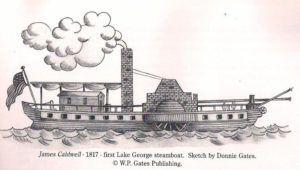 The James Caldwell was built in 1817 at a cost of only $12,000. She was the first steamship on Lake George. Approximately 80 feet long and 20 feet wide, she was constructed of wood and weighed 120 tons. She had a maximum speed of 4 mph. Constructed in the same shape as the canal-boats of the time, she had two long boilers and a brick smokestack. Her engines were salvaged off a steamship that had sunk in Lake Champlain just two years before. Her job was to ferry people and supplies around the various towns around the lake. In 1817, this was the only real mode of transportation around the lake, as there were no roads at the time. Then in 1821, after just 4 seasons of operating on Lake George, the James Caldwell burned down mysteriously while at dock.
The James Caldwell was built in 1817 at a cost of only $12,000. She was the first steamship on Lake George. Approximately 80 feet long and 20 feet wide, she was constructed of wood and weighed 120 tons. She had a maximum speed of 4 mph. Constructed in the same shape as the canal-boats of the time, she had two long boilers and a brick smokestack. Her engines were salvaged off a steamship that had sunk in Lake Champlain just two years before. Her job was to ferry people and supplies around the various towns around the lake. In 1817, this was the only real mode of transportation around the lake, as there were no roads at the time. Then in 1821, after just 4 seasons of operating on Lake George, the James Caldwell burned down mysteriously while at dock.
The Mountaineer (I)
 In 1824, at a cost of $12,000, the Mountaineer (I) was built. She was built right on Pine Point in Caldwell (which is now Lake George Village). 100 feet long and 16 feet wide, she had an 8 foot draft and weighed 125 tons. She had a 20 horsepower steam engine which could push her up to 6 mph. She was built in a very unique way. Her wooden hull was built without rib frames. Instead, 3 layers of oak planking were laid in alternating horizontal and vertical directions, giving the hull extreme bending and twisting flexibility. This was pretty much an early experiment for what we now know as plywood.
In 1824, at a cost of $12,000, the Mountaineer (I) was built. She was built right on Pine Point in Caldwell (which is now Lake George Village). 100 feet long and 16 feet wide, she had an 8 foot draft and weighed 125 tons. She had a 20 horsepower steam engine which could push her up to 6 mph. She was built in a very unique way. Her wooden hull was built without rib frames. Instead, 3 layers of oak planking were laid in alternating horizontal and vertical directions, giving the hull extreme bending and twisting flexibility. This was pretty much an early experiment for what we now know as plywood.
She made 2 trips to Ticonderoga (32 miles up the lake) each week. The other days were used much as we use our boats today; for sightseeing. The ship was very successful in her time on the lake. Many people were willing to pay the $2.00 fee for the ship ride. The Mountaineer ran successfully for 13 years until 1836 when she was retired and allowed to slowly rot and sink in Ticonderoga Creek.
William Caldwell
 The William Caldwell was built at the northern end of Lake George in Ticonderoga in the spring of 1838. She was 140 feet long and 17 feet wide, she weighed about 150 tons and had an 8 foot draft. She was another side-wheel steamship operated by a Fulton type of “steeple-engine” which operated a horizontal cross beam up and down. This engine and her design helped her to achieve speeds of 12 mph.
The William Caldwell was built at the northern end of Lake George in Ticonderoga in the spring of 1838. She was 140 feet long and 17 feet wide, she weighed about 150 tons and had an 8 foot draft. She was another side-wheel steamship operated by a Fulton type of “steeple-engine” which operated a horizontal cross beam up and down. This engine and her design helped her to achieve speeds of 12 mph.
She operated daily round trips from the Lake House Dock in Lake George Village to Ticonderoga. She would leave every day from Lake George at 8 am and journey up the lake to Ticonderoga. In Ticonderoga, she would remain at the dock for 3.5 hours so her passengers could take a horse and carriage to the old ruins of Fort Ticonderoga where they would get out to walk around and view the ruins. They were then transported back to the boat which would leave Ticonderoga at 3 pm and steam back south to Caldwell.
After only 10 years of service, the William Caldwell was already showing signs of deterioration. In 1848 she was retired and abandoned in the bay north of what is today’s Shepard Park Beach. Shepard Park Beach is in the middle of Lake George Village, so the ship was probably abandoned right out in front of the Georgian Motel or Lakeside Motel. She eventually sank and disintegrated in that bay.
John Jay
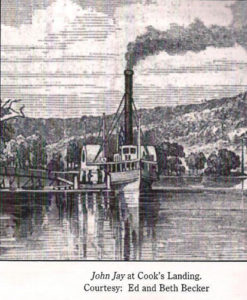 The John Jay was launched in the spring of 1850. She was another side-wheel steamship. She was 145 feet long and 20 feet wide and she drafted 8 feet while weighing 250 tons. Her wooden hull was made completely out of oak. She had a 75 horsepower wood-fired steam engine which moved the boat at a steady 13 mph.
The John Jay was launched in the spring of 1850. She was another side-wheel steamship. She was 145 feet long and 20 feet wide and she drafted 8 feet while weighing 250 tons. Her wooden hull was made completely out of oak. She had a 75 horsepower wood-fired steam engine which moved the boat at a steady 13 mph.
She made daily 7am trips from Caldwell to Cook’s Landing in Ticonderoga where she was met by stage coaches which would then take passengers to and from a landing on Lake Champlain.
But the John Jay’s life was tragically cut short. On Tuesday July 29th, 1856 a fire broke out on the ship and burnt through the steering cables. The Captain (E.S. Harris) braved the flames to reach the emergency steering system in the stern of the ship. He was blinded by smoke and he steered the ship into a large exposed rock which sent the boat to careen out into the lake. As the fire spread the passengers jumped into the lake to escape the flames. The ship then sank into the depths of Lake George to the south of the Cook’s Island at Temple Knolls. The only deadly accident in the company’s long history had claimed the lives of 6 people. The John Jay’s remains, although badly decayed, can still be seen today.
Minne Ha Ha (I)
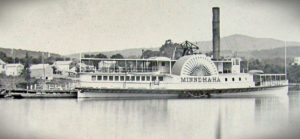 The John Jay’s engines and boiler were salvaged and installed on the next ship to sail the lake, the Minne Ha Ha (I). The first Minne was 144 feet long (7 feet longer than the current Minne Ha Ha), 22 feet wide, and drafted 8 feet of water. She displaced 260 tons of water and her wood-fired walking beam engine propelled her to a speed of 13 mph.
The John Jay’s engines and boiler were salvaged and installed on the next ship to sail the lake, the Minne Ha Ha (I). The first Minne was 144 feet long (7 feet longer than the current Minne Ha Ha), 22 feet wide, and drafted 8 feet of water. She displaced 260 tons of water and her wood-fired walking beam engine propelled her to a speed of 13 mph.
She was launched in the Spring of 1857. She ran a trip to Ticonderoga daily. She would leave Lake George Village at 7:30 am, steam all the way up to Ticonderoga (32 miles up the lake at its northern end) and then she would steam back down to Lake George and arrive at 6 pm.
She ran very successfully on Lake George until 1878, at this point her engines were removed and sold (for $16,000) to a boat-builder in British Columbia. The boat herself was then sold to a Cyrus Butler, owner of the then popular Horicon Pavilion Hotel up on Black Mountain Point. She occupied this job for a couple years before she fell into utter disrepair and sank in 14 feet of water.
Ganouskie
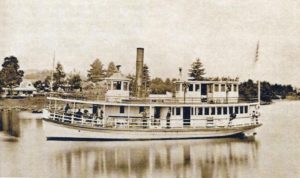 By the mid 1860’s it was clear that the Minne Ha Ha (I) couldn’t handle the increase in business and traffic from people arriving to Lake George by way of trains (first tracks built into Lake George came in 1882). The decision came that there needed to be another ship in the fleet to accommodate all these people, and thus in 1869 the Ganouskie was completed.
By the mid 1860’s it was clear that the Minne Ha Ha (I) couldn’t handle the increase in business and traffic from people arriving to Lake George by way of trains (first tracks built into Lake George came in 1882). The decision came that there needed to be another ship in the fleet to accommodate all these people, and thus in 1869 the Ganouskie was completed.
The Ganouskie was the smallest ship ever to sail in the Company’s 199 year history. She was only 72 feet long and weighed 67 tons (the Mohican weighs 200 tons). She was made entirely of wood and had a single main deck. She was the first propeller driven ship on Lake George. This propeller was initially fired by a wood burner boiler, but then in 1877 new grates were made so she could burn coal instead.
The Ganouskie’s job was to carry up to 50 people southward while the Minne Ha Ha (I) carried them northward. In 1870 the Ganouskie started to transport mail and other small packages. This was the first time in the Lake’s history that two steamboats provided simultaneous service.
In 1884 it was deemed that the Ganouskie had outlived its usefulness. She was then laid up in the Baldwin Shipyard and later in 1885 had her engines dismantled and shipped to Shelburne Bay on Lake Champlain.
Horicon (I)
![]() The Horicon was built in Ticonderoga and launched from Cook’s Landing in 1877. Her name was derived from James Fenimore Cooper’s novel “Last of the Mohicans,” Horicon being the name of the Lake in the novel. She was the 2nd longest ship in the Lake’s History at 195 feet. She was 30 feet wide, drafted 9 feet, and displaced 643 tons. Her 270 horsepower, second hand engines propelled her to an speed of 20 mph. She once made the trip from Lake George Village to Ticonderoga in 1 hour and 45 minutes. She was made entirely of wood and no expense was spared. She had grand saloons and cabins, her main saloon was 108 feet long and 27 feet wide and adorned with native woods. And she was topped with a beautiful hand-carved American Bald Eagle mounted on the top of the mast.
The Horicon was built in Ticonderoga and launched from Cook’s Landing in 1877. Her name was derived from James Fenimore Cooper’s novel “Last of the Mohicans,” Horicon being the name of the Lake in the novel. She was the 2nd longest ship in the Lake’s History at 195 feet. She was 30 feet wide, drafted 9 feet, and displaced 643 tons. Her 270 horsepower, second hand engines propelled her to an speed of 20 mph. She once made the trip from Lake George Village to Ticonderoga in 1 hour and 45 minutes. She was made entirely of wood and no expense was spared. She had grand saloons and cabins, her main saloon was 108 feet long and 27 feet wide and adorned with native woods. And she was topped with a beautiful hand-carved American Bald Eagle mounted on the top of the mast.
She ran daily trips north to Ticonderoga opposite of the Ganouskie carrying people and goods to Ticonderoga and various other points throughout the lake.
During the winter of 1901-1902, she was completely renovated at a cost of $25,057 ($647,822.24 in today’s dollars). Even her hull was completely replaced (with the exception of her keel). After 34 consecutive sailing seasons, still being in good sailing condition, she was retired and dismantled in 1911.
Ticonderoga (I)
![]() The Ticonderoga was built and launched at Cook’s Landing in Ticonderoga, she was the last large ship built on Lake George that was built entirely out of wood. She was 172 feet long, 28 feet wide, and drafted 9 feet of water, this 500 ton ship (the Saint weighs 540 tons) was also capable reaching speeds of 20 mph.
The Ticonderoga was built and launched at Cook’s Landing in Ticonderoga, she was the last large ship built on Lake George that was built entirely out of wood. She was 172 feet long, 28 feet wide, and drafted 9 feet of water, this 500 ton ship (the Saint weighs 540 tons) was also capable reaching speeds of 20 mph.
From 1884-1901 she sailed simultaneously with the Horicon (I).
But all of her success was tragically short-lived. On August 29, 1901 a fire was discovered below deck. She quickly landed at the nearby Rodger’s Rock Hotel to unload all of her passengers. After everyone was safely off her, the Captain (Captain Frank G. White) stayed with his ship until the lines which held her to the dock burned up. Without these lines, she drifted northward across the bay. She then burned right down to her water line and soon after sank in the shallow waters of Heart’s Bay.
Mohican (I)
 The first Mohican was built in Lake George Village on Pine Point. She was launched in 1894, she was 93 feet long and 17 feet wide and weighed 150 tons (the current Mo weighs 200 tons). She was propelled by a single 200 horsepower steam engine which worked a single propeller.
The first Mohican was built in Lake George Village on Pine Point. She was launched in 1894, she was 93 feet long and 17 feet wide and weighed 150 tons (the current Mo weighs 200 tons). She was propelled by a single 200 horsepower steam engine which worked a single propeller.
She wasn’t originally built for the Steamboat Company, but she was later purchased by the company. The company then improved the main deck, added steam heating, carpeting, and toilets among other things.
She sailed daily from Baldwin (Ticonderoga) at 7:20 am, stopping at all of the landings when signaled to, and arrived at Caldwell just in time to catch the 11:25 am southbound train. She then left Caldwell to head back up to Ti at 2:45 pm and (once again after making all her landings) arrived in Baldwin at 6:30 pm. During busy times in the summer, she also made stops in Paradise Bay and the Narrows.
After 14 years of faithful service the Mohican (I) was retired in 1908, just as the new steel-hulled Mohican (II) was rolled into service to replace her. The first Mohican was dismantled in Ticonderoga that same year.
Sagamore
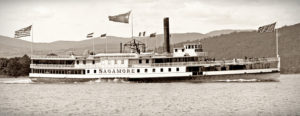 The Sagamore was originally 203 feet long, 57.5 feet wide, drew 7 feet of water, and weighed 1,125 tons. She was the first steel-hulled ship to ply the waters of Lake George. She could carry up to 1,500 passengers and she could travel at speeds of 20 mph (that’s faster than the both the current Mohican and the Saint can go) thanks to her walking beam steam engine (which would turn her massive side wheel paddlewheels) that put out 850 horsepower.
The Sagamore was originally 203 feet long, 57.5 feet wide, drew 7 feet of water, and weighed 1,125 tons. She was the first steel-hulled ship to ply the waters of Lake George. She could carry up to 1,500 passengers and she could travel at speeds of 20 mph (that’s faster than the both the current Mohican and the Saint can go) thanks to her walking beam steam engine (which would turn her massive side wheel paddlewheels) that put out 850 horsepower.
She was launched on April 23, 1902 in front of one of the largest crowds in Lake George history. But later on that year it was determined that the ship was too top heavy and wide. So after the season she was taken up to Baldwin, hauled out and cut into 2 pieces; 20 feet was added to her midships, bringing her to the grand total length of 223 feet.
During her years of service the Sagamore would offer quite a deal. For only $1.50 the Sagamore would take you from Caldwell (Lake George Village) and stop at all the hotels and landings around the lake, for another buck you would be served a fine meal along the journey.
But the Sagamore’s life wasn’t always so cheery. On Friday July 1, 1927 the Sagamore became lost in a very dense fog. Usually when this happened, the captains would use the clock and listen to the paddlewheel revolutions echoing off the mountains and shoreline to know where and when to turn. On July 1, 1927, however, the captain got it wrong and collided head on with the rocky cliffs of Anthony’s Nose (a mountain at the northern end of the Lake). Her steel hull was split severely and immediately began to sink. The captain managed to get her plugged up with mattresses. This bought him enough time to make it into shallow water, where she sunk in only 18 feet of water.
Three weeks later the Sagamore was refloated and towed to Baldwin for repair, but the old Drydock couldn’t handle the Sagamore’s size and weight. After many months of work and $35,000 in 1928, a new marine railway was built by Crandall Marine out of Boston, Mass. The ship could finally be brought up and repaired (which cost $30,000 due to the tremendous water damage that had been done).
The Sagamore was put back into service in May of 1928. She continued service until 1932 when she was retired. After spending 5 years tied up in Baldwin, she was finally dismantled and sold for scrap in 1937.
Horicon (II)
![]() In 1910 the company built the 2nd Horicon up at its dry dock in Baldwin (2 miles south of Ticonderoga). She was the longest and fastest passenger-carrying vessel ever to sail on Lake George. She was 230 feet long and 59 feet wide at her widest point. She displaced 1175 tons and drew 7.5 feet of water. Her two twin boilers (lobster return type) with a 10 foot piston stroke powered her walking beam engine with 1280 horsepower, this propelled her and her (max capacity) 1,500 possible passengers to a speed of 21 mph! A truly magnificent vessel, but she gets better.
In 1910 the company built the 2nd Horicon up at its dry dock in Baldwin (2 miles south of Ticonderoga). She was the longest and fastest passenger-carrying vessel ever to sail on Lake George. She was 230 feet long and 59 feet wide at her widest point. She displaced 1175 tons and drew 7.5 feet of water. Her two twin boilers (lobster return type) with a 10 foot piston stroke powered her walking beam engine with 1280 horsepower, this propelled her and her (max capacity) 1,500 possible passengers to a speed of 21 mph! A truly magnificent vessel, but she gets better.
She had an elegant dining room, a saloon, and several small cabins built on her decks. In the 1920’s she was even modified to carry small automobiles between landings in the stern section of her first deck. She was very successful early in her career, and on more then one occasion she actually carried over her maximum capacity.
But with the completion of the highway up over Tongue Mountain in the late 1920’s (successfully connecting Lake George to Ticonderoga and all the little hamlets in between) passenger counts dropped off tremendously. To try and resuscitate passenger counts, in 1933, the Horicon (II) was turned into a “Show Boat.” From 1933 to 1938 the company would import well known bands to Lake George to play on the Horicon (II) as she went out on her relatively popular evening dance cruise.
But the great depression hampered any kind of success for the ship. In 1937 she was only making two 2.5 hour trips a day for only the cost of $1.00, and in 1939 she didn’t even sail once.
In the fall of 1939 she was sold for $5,000 to a scrap yard in Troy, NY, and later that year the last side wheel steamboat on Lake George was dismantled in Baldwin, where she was built just 28 years before.
Ticonderoga (II)
![]() The Ticonderoga was the first of only 2 Lake George Steamboat Company ships to not be built on Lake George. She began her life, in August of 1944, as a U.S. Navy ship. She was built in exactly 13 days. She earned her battle ribbons sailing in the Pacific during the final year of WWII. After the war she was sailed to Brooklyn Navy Yard and retired at anchor on July 16th, 1947. The company then purchased her from the Navy in 1949 for $11,000.
The Ticonderoga was the first of only 2 Lake George Steamboat Company ships to not be built on Lake George. She began her life, in August of 1944, as a U.S. Navy ship. She was built in exactly 13 days. She earned her battle ribbons sailing in the Pacific during the final year of WWII. After the war she was sailed to Brooklyn Navy Yard and retired at anchor on July 16th, 1947. The company then purchased her from the Navy in 1949 for $11,000.
She was sailed up the Hudson River, through the Champlain Canal, and into Lake Champlain. She sailed to a point near Ticonderoga and at this point she was then cut into 4 sections and moved 5 miles overland to the company’s dry dock in Baldwin on Lake George. When she arrived at Baldwin, she was reassembled for a cost of $250,000 (a cost of $2.4 million in today’s money) as a passenger vessel. The Vessel, renamed the “Ticonderoga”, was launched in Lake George in October of 1950.
The Ticonderoga (II) was 168 feet long and 25.5 feet wide and she displaced roughly 360 tons of water (which is equal to the overall weight of the ship). Her twin diesel engines totaled 900 horsepower, thus powering her to a speed of roughly 14 mph.
With her initial voyage the Steamboat Company began once again the complete round trip service through the lake, this service had been dropped after the 1933 season. From 1951 until 1989 she carried tens of thousands of passengers without incident.
By the early 1980’s she began to show signs of wear and tear. It was then decided to replace her with a newer and larger vessel. When the Lac du Saint Sacrement was christened in 1989, the Ticonderoga was tied to the end of the pier, serving as a kind of “floating warehouse” and crew storage.
In 1993 it was decided, begrudgingly, that the Ticonderoga had to be scrapped, her condition was just that bad. Later that year on October 13th she made her last voyage through the lake, accompanied by a flotilla of boats paying her respects. When she reached the dry dock in Ticonderoga, NY she was raised out of the water and during the next couple months she was cut apart and sold for scrap metal. To this day, people ask us about the Ticonderoga. She is firmly and fondly entwined in the memories of people from this area.



